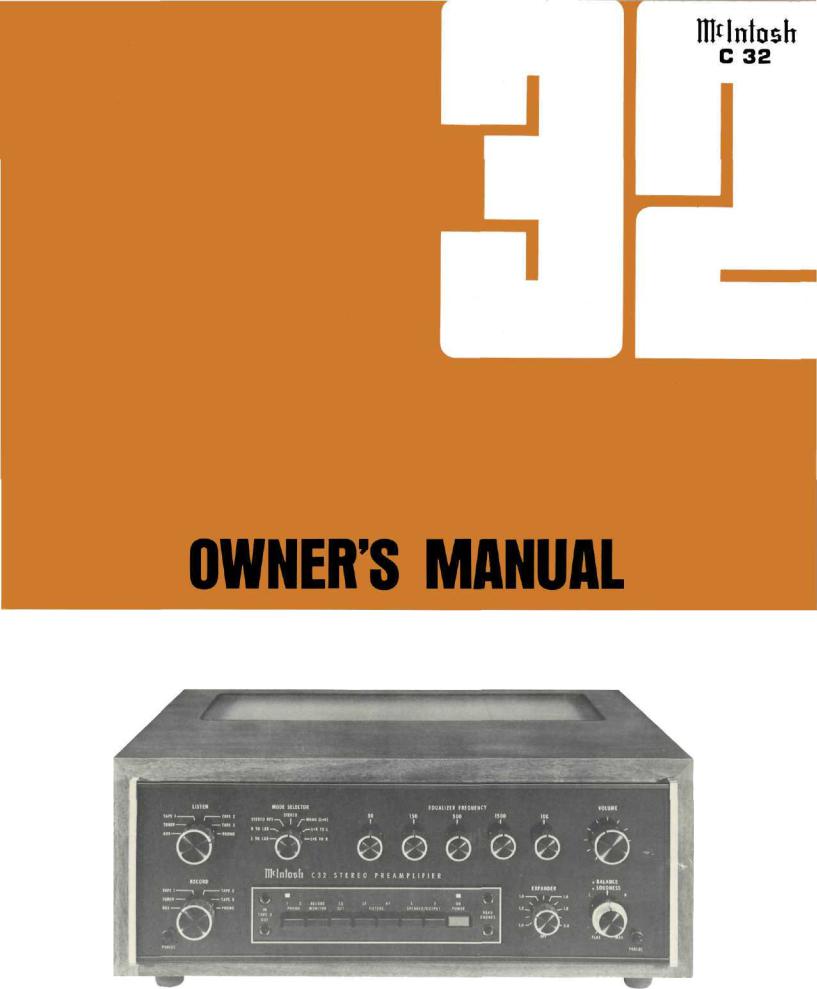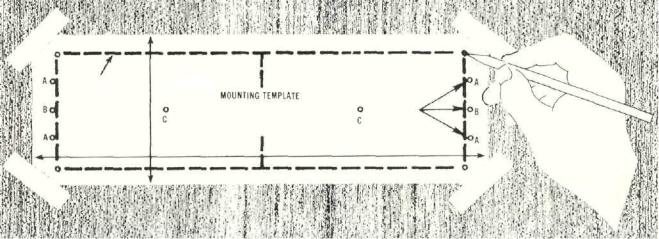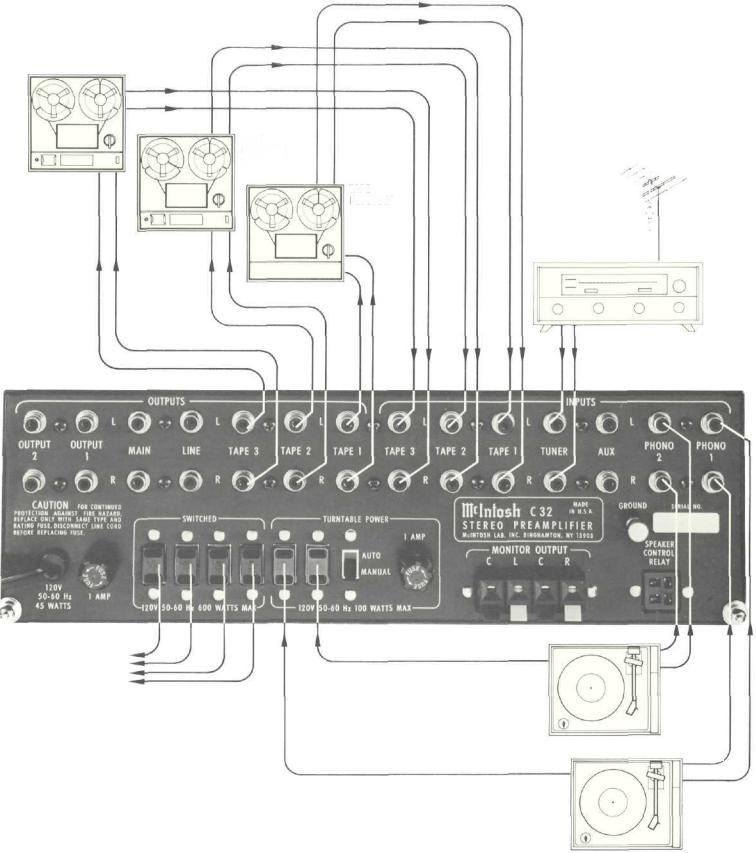McIntosh C-32 Owners manual

THE MclNTOSH C32 SOLID STATE STEREO PREAMPLIFIER
Reading Time: 44 Minutes |
Price $1.25 |

WARNING: TO PREVENT FIRE OR SHOCK HAZARD, DO NOT EXPOSE THIS UNIT TO
RAIN OR MOISTURE.
The Mclntosh you have purchased has a serial number located on the rear panel of the chassis.
Record that serial number here
for future references. The model and serial number are important to you for any future service.

Your C 32 Stereo Preamplifier will give you many years of pleasant and satisfactory performance. If you
have any questions, please contact:
CUSTOMER SERVICE
Mclntosh Laboratory Inc.
2 Chambers Street
Binghamton, New York 13903
Phone: 607-723-3512
Take Advantage of 3 years of FREE Service...
FillintheApplicationNOW.
Contents
INTRODUCTION |
2 |
|
|
|
|
HOW TO INSTALL |
2 |
|
|
|
|
HOW TO CONNECT |
4 |
|
|
|
|
USING THE FRONT PANEL CONTROLS |
8 |
|
|
|
|
USING THE PUSHBUTTONS |
11 |
|
|
|
|
BALANCING YOUR STEREO |
12 |
|
|
|
|
LISTENING TO YOUR STEREO |
12 |
|
PERFORMANCE LIMITS AND RATINGS |
|
13 |
|
|
|
PERFORMANCE CHARTS |
14, 15 |
|
|
|
|
TECHNICAL DESCRIPTION |
16 |
|
BLOCK DIAGRAM |
|
19 |
|
|
|
THREE YEAR SERVICE CONTRACT
An application for a FREE THREE YEAR SERVICE CONTRACT is included with this manual.
The terms of the contract are: |
|
|
|
|
|
mishandling is not covered by the SERVICE |
||||||||||||||
|
|
|
|
|
|
|
|
|
|
|
CONTRACT. |
|
|
|
|
|
|
|
||
|
|
|
|
|
|
|
|
|
|
4. |
The |
SERVICE CONTRACT |
is |
issued |
to |
you as |
||||
1. Mclntosh will provide all parts, materials and |
|
the |
original purchaser. |
To |
protect |
you |
from |
|||||||||||||
|
misrepresentation |
this |
contract |
cannot be |
||||||||||||||||
labor needed |
to |
return |
the measured |
perfor- |
|
|||||||||||||||
|
transferred to a second owner. |
|
|
|
||||||||||||||||
mance of the instrument to the original per- |
|
|
|
|
||||||||||||||||
|
|
|
|
|
|
|
|
|
|
|
||||||||||
formance |
limits |
free of any charge. The |
5. |
For your protection Mclntosh selects |
only |
|||||||||||||||
SERVICE |
CONTRACT |
does |
not |
cover |
any |
dealers who have technical competence to |
||||||||||||||
shipping costs to and from the authorized |
|
guide purchasers fairly, and provide service |
||||||||||||||||||
service agency or the factory. |
|
|
|
|
|
when necessary. To receive the SERVICE |
||||||||||||||
2. Any |
Mclntosh |
authorized |
service |
agency |
|
CONTRACT your |
purchase |
must |
be |
made |
||||||||||
|
from a Mclntosh |
franchised |
dealer. |
|
|
|||||||||||||||
will repair Mclntosh instruments at normal |
|
|
|
|||||||||||||||||
|
|
|
|
|
|
|
|
|
|
|
||||||||||
service rates. To receive the free service |
6. |
Your completely filled in application for a |
||||||||||||||||||
under the terms of the SERVICE CONTRACT, |
|
SERVICE |
CONTRACT |
must |
be |
postmarked |
||||||||||||||
the |
SERVICE |
CONTRACT |
CERTIFICATE |
must within 30 |
days of the date of purchase of the |
|||||||||||||||
accompany |
the |
instrument |
when |
taken |
to |
|
instrument. |
|
|
|
|
|
|
|
||||||
the |
service |
agency. |
|
|
|
|
|
7. |
To receive the SERVICE CONTRACT all in- |
|||||||||||
|
|
|
|
|
|
|
|
|
|
|||||||||||
3- Always have service done by a Mclntosh |
|
formation on the application must be filled |
||||||||||||||||||
authorized service agency. If the instrument |
|
in. The SERVICE CONTRACT will be issued |
||||||||||||||||||
is modified or damaged, as a result of un- |
|
when the completely filled in application is |
||||||||||||||||||
authorized repair the SERVICE CONTRACT |
|
received at Mclntosh Laboratory Incorporated |
||||||||||||||||||
will be cancelled. Damage by improper use or |
|
in Binghamton, New York. |
|
|
|
|
|
|||||||||||||
Copyright © 1977 by Mclntosh Laboratory Inc. |
1 |

Introduction
The Mclntosh C 32 preamplifier provides the most com-
prehensive |
range |
of functions and control options. Many |
of these are new |
in a preamplifier. The C 32 can only |
|
serve you |
best when you understand what its functions |
|
are and what it is designed to do. Spend some time with this manual and get to know how this preamplifier works.
The C 32 is a "dual" stereo preamplifier with a built-in MONITOR POWER AMPLIFIER. There are two totally independent left and right stereo program lines running through the preamplifier. One program line is the LISTEN program line, the other is the RECORD program line. Each program line can select its own program source from any connected input signal—i.e. PHONO, TUNER, AUX, or TAPES 1, 2 or 3 without interference with the other program line.
The output of the LISTEN program line is affected by all the front panel controls (except the RECORD switch) and is fed to the OUTPUT MAIN and/or OUTPUT 1 and 2 jacks as selected by front panel pushbuttons. The output of the RECORD program line is not affected by front panel controls (except the RECORD switch) and is fed to all OUTPUT RECORD jacks.
The MONITOR AMPLIFIER program may be selected from either the LISTEN or RECORD program lines. Separate GAIN controls for LEFT AND RIGHT MONITOR AMPLIFIER are located on the top panel. The signal selected for the MONITOR AMPLIFIER is fed to the front panel HEADPHONE jacks and the rear panel OUTPUT LINE and MONITOR OUTPUT connectors.
How to install
The PANLOC system of installing equipment conveniently and securely is a direct result of Mclntosh research. By depressing the two PANLOC buttons on the front panel of the C 32, the instrument either can be locked firmly in place or unlocked so that the chassis can be slid forward, giving you easy access to the top and rear panels.
The trouble-free life |
of an electronic instrument is |
||
greatly |
extended by |
providing sufficient ventilation |
to |
prevent |
the buildup of |
high internal temperatures |
that |
cause deterioration. Allow enough clearance so that cool air can enter at the bottom of the cabinet and be vented
from the top. With adequate ventilation the instrument can be mounted in any position. The recommended mini-
mum space |
for installation is 15 inches |
(38.1 |
cm) |
deep, |
|||
17 inches (43.2 cm) wide, and 6 inches |
(15.2 |
cm) |
high. |
||||
|
To install |
the instrument in a Mclntosh cabinet, follow |
|||||
the instructions that are enclosed with |
the |
cabinet. For |
|||||
any other type of installation: |
|
|
|
|
|||
1. |
Unpack from Carton |
|
|
|
|
||
|
Remove the instrument PANLOC brackets, hardware |
||||||
|
package, and mounting template from the carton. Re- |
||||||
|
move the C 32 from its plastic bag and place it upside |
||||||
|
down on the shipping pallet; unscrew the four plastic |
||||||
|
feet from the bottom of the chassis. |
|
|
|
|||
2. |
Mark |
for |
Position |
|
|
|
|
|
Place |
the |
mounting template |
in position to cover the |
|||
|
area of the cabinet panel where the instrument is to be |
||||||
|
installed, and tape it in place. The broken lines that |
||||||
|
represent the outline of the rectangular cutout also |
||||||
|
represent the outside dimensions of the chassis. Make |
||||||
|
sure these lines clear shelves, partitions, or any equip- |
||||||
|
ment. With the template in place, first mark the six A |
||||||
|
and B holes and the four small holes that locate the |
||||||
|
corners of the cutout. Then, join the four corner mark- |
||||||
|
ings with |
pencil lines, using |
the edge of the template |
||||
as a straightedge.
2

3. Drill Holes |
|
|
Using a drill with a 3/16 inch bit held |
perpendicular to |
|
the panel, drill the six A and B holes. Then, using a |
drill |
|
bit slightly wider than the tip of your |
saw blade, |
drill |
one hole at each of two diagonally opposite corners. The |
||
holes should barely touch the inside edge of the pencilled |
||
outline. Before taking the next step, |
make sure that |
|
the six A and B holes have been drilled.
4. |
Saw Panel Cutout |
|
|
|
|
|
Sawing carefully on the inside of the |
pencilled |
lines, |
||
|
first make the two long cuts and then |
the |
two |
short. |
|
|
After the rectangular opening has been |
cut |
out, |
use a |
|
|
file to square the corners and smooth any irregularities |
||||
|
in the |
cut edges. |
|
|
|
5. |
Install |
Mounting Strips |
|
|
|
In the hardware package you will find two mounting strips and two sets of machine screws. For panels that are less than ½ inch thick, use the ¾ inch screws; for panels that are more than ½ inch thick, use the 1¼ inch screws.
Starting at the right-hand side of the panel, insert a screw of the proper length into the center hole in the panel, marked B on the template. On the back of the panel, align a mounting strip with the holes in the panel and tighten the screw until the screwhead is pulled slightly into the wood.
Repeat |
this |
procedure to attach the mounting strip |
to the left |
side |
of the panel. |
6. Attach PANLOC Brackets
Using two screws of the proper length in the A holes on each side, attach the PANLOC brackets to the cabinet panel; the short flange is mounted against the front (face) of the cabinet panel. The screws pass through the PANLOC bracket flange, the cabinet panel, and then through the mounting strips previously mounted.
7. Install Instrument
Guide the AC power cord through the panel opening to the back of the cabinet; then, slide the instrument into
the opening carefully so that the rails on the bottom of each side of the chassis engage the tracks on the mounting brackets. Continue to slide the instrument into the cabinet until it is stopped by the adjust position latches. Press the latches inward, this permits the instrument to slide into the cabinet until its front panel is flush with
the cabinet panel. Depress the PANLOC buttons at the lower left and right corners of the instrument panel to
lock the unit firmly in the cabinet. Depressing the PANLOC buttons again will unlock the instrument so that it can be slid forward to the adjust position; pressing inward on the adjust position latches permits removal from the cabinet
3
How to Connect
CONNECTING A TURNTABLE TO PHONO 1
Connect the cable from the "left" channel of the turntable into the INPUT L PHONO 1 jack.
Connect the cable from the "right" channel of the turntable into the INPUT R PHONO 1 jack.
PHONO 2 is provided for the use of a second turntable. Connect the cable from the "left" channel of the turn-
table into the INPUT L PHONO 2 jack.
Connect the cable from the "right" channel of the turntable into the INPUT R PHONO 2 jack.
On the rear panel are two green AC power outlets and a slide switch marked AUTO/MANUAL. Plug the AC power cables from the turntable into the green TURNTABLE
POWER outlets on the rear panel. |
When the switch is in |
|||||
the |
AUTO |
position, |
power |
to |
the |
black AC power out- |
lets, can be controlled by |
the |
front |
panel POWER switch |
|||
or |
by the |
current |
drawn |
by |
a |
turntable plugged into |
the green TURNTABLE POWER outlets. The current sens-
ing |
green AC power outlets |
will |
control the |
AC power |
to |
the entire system from the |
AC |
power on/off |
switch on |
the turntable. When the turntable is turned off with its own AC power switch, no current is drawn which causes the current sensing relays in the C 32 to turn oft all AC power to the system. With the AUTO/MANUAL switch in the MANUAL position, AC power to the system will be controlled by the front panel POWER pushbutton only.
Some turntables have electronic circuits that draw current all the time. To use these turntables the AUTO/MANUAL switch must be in the MANUAL position.
The green AC power outlets are protected with a one ampere fuse. Any increase in the value of this fuse will affect the operation of the sensing circuit and can cause severe damage.
GROUND CONNECTION
A single ground post is provided. Grounds for turntables, record changers, tape decks, etc. should be connected to this post. The left and right program cables and the ground wire from that source should be wound or twisted together. To avoid hum, make sure the ground wire does not make any connections to the shields of the left and right program cables between the program source and the C 32.
CONNECTING A STEREO TUNER |
|
Connect the cable from the "left" channel |
tuner output |
to the INPUT L TUNER jack. |
|
Connect the cable from the "right" channel tuner output |
|
to the INPUT R TUNER jack. |
|
AUX—Any high level program source such |
as a tuner, |
a TV set or a tape recorder can be connected to the INPUT AUX jacks.
CONNECTING TAPE RECORDERS
To Record:
Connect a cable from the OUTPUT L TAPE 1 jack to the
left high level input of the tape recorder.
Connect a cable from the OUTPUT R TAPE 1 jack to the right high level input of the tape recorder
Connect second and third tape recorders in the same fashion to the TAPE 2 and TAPE 3 outputs.
To Playback/Monitor:
Connect the cable from the left channel output of a tape recorder to the INPUT L TAPE 1.
Connect the cable from the right channel output of a tape recorder to the INPUT R TAPE 1.
Connect second and third tape recorders in the same fashion to the TAPE 2 and TAPE 3 INOUT jacks.
TAPE RECORDER FRONT PANEL CONNECTION
Inputs and outputs for TAPE 3 are available at the TAPE 3 IN-OUT jacks on the front panel just left of the pushbuttons. This allows rapid, temporary connections to TAPE 3 position
without |
getting |
at |
the |
rear panel, A metal shielded V |
stereo |
phone |
plug |
is |
used for best shielding—similar to |
the plugs used on low impedance headphones. Connections follow the industry standards and are tip: left signal, ring: right signal, and, sleeve: common ground
Connecting a Tape Recorder to the Listen Program Line
Connect a cable from the OUTPUT 1 —LEFT jack to the left high level input of the tape recorder
Connect a cable from the OUTPUT 1—RIGHT jack to the right high level input of the tape recorder.
Output signal will be ted to the tape recorder when the front panel pushbutton OUTPUT 1 is pushed in.
CONNECTING THE C 32 TO POWER AMPLIFIERS
Connect the OUTPUT MAIN jacks to the input of a stereo power amplifier. The Left MAIN jack is connected to the left amplifier input jack. The Right MAIN jack is connected to the right amplifier input jack.
Two additional stereo power amplifiers may be connected in the same fashion to the OUTPUT 1 and OUTPUT 2 jacks. Audio output signal is supplied to these jacks only when front panel pushbutton SPEAKER/OUTPUT 1 and 2 pushbuttons are pressed IN. The input impedance of the amplifiers used should be 5,000 ohms or greater.
SPEAKER CONTROL RELAY
To control loudspeakers by use of SPEAKER/OUTPUT 1 and 2 pushbuttons on the front panel an accessory Mclntosh SCR (SPEAKER CONTROL RELAY) is needed. Plug the special cable from the SCR control into the SPEAKER CONTROL RELAY receptacle. The speakers are then connected to the SCR control.
The SCR has two AC power outlets that provide additional capacity of 2400 watts. Use these outlets to supply AC power to amplifiers or other components to be controlled by the ON OFF cycle of the C 32. Use the SCR whenever the total load to be switched by the C 32 exceeds its rating of 600 watts.
4

TAPE RECORDER 3
TAPE
R E C O R D E R 2
TAPE
R E C O R D E R |
|
1 |
FM ANTENNA |
T U N E R
AC POWER TO |
AC POWER |
|
|
||
TAPE RECORDERS. |
||
TUNERS, |
|
T U R N T A B L E #2 |
POWER |
||
AMPLIFIERS. |
|
|
TOTAL OF 600 WATTS. |
||
FOR MORE AC |
POWER |
|
USE THE |
SCR |
SPEAKER |
CONTROL |
RELAY |
|
AC POWER
TURNTABLE #1
5
